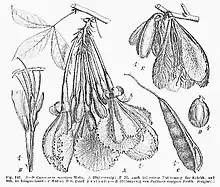Camoensia (plant)
Camoensia is a genus of 2 species of lianas in the family Fabaceae, subfamily Faboideae, native to the Gulf of Guinea, Africa. C. scandens is cultivated as an ornamental plant; it has one of the largest leguminous flowers, up to 20 cm across.[5] The genus has classically been assigned to the tribe Sophoreae,[6] but was recently assigned to its own monophyletic tribe, Camoensieae, on the basis of molecular phylogenetic evidence.[1][2][7][8] Species of Camoensia are known to produce quinolizidine alkaloids, consistent with their placement in the genistoid clade.[6][9]
| Camoensia | |
|---|---|
 | |
| Camoensia scandens: illustrations A-D | |
| Scientific classification | |
| Kingdom: | |
| (unranked): | |
| (unranked): | |
| (unranked): | |
| Order: | |
| Family: | |
| Subfamily: | |
| (unranked): | |
| Tribe: | Camoensieae |
| Genus: | Camoensia |
| Species[3][4] | |
| |
| Synonyms | |
| |
References
- Cardoso D, Pennington RT, de Queiroz LP, Boatwright JS, Van Wyk BE, Wojciechowski MF, Lavin M (2013). "Reconstructing the deep-branching relationships of the papilionoid legumes". S Afr J Bot. 89: 58–75. doi:10.1016/j.sajb.2013.05.001.
- Wojciechowski MF (2013). "Towards a new classification of Leguminosae: Naming clades using non-Linnaean phylogenetic nomenclature". S Afr J Bot. 89: 85–93. doi:10.1016/j.sajb.2013.06.017.
- "ILDIS LegumeWeb entry for Camoensia". International Legume Database & Information Service. Cardiff School of Computer Science & Informatics. Retrieved 12 February 2014.
- USDA; ARS; National Genetic Resources Program. "GRIN species records of Camoensia". Germplasm Resources Information Network—(GRIN) [Online Database]. National Germplasm Resources Laboratory, Beltsville, Maryland. Archived from the original on 24 September 2015. Retrieved 12 February 2014.
- Mabberley DJ (1997). The Plant-Book: A Portable Dictionary of Plants, their Classifications, and Uses (2nd ed.). Cambridge University Press, UK. pp. 858. ISBN 0-521-41421-0.
- Polhill RM (1981). "Sophoreae". In Polhill RM, Raven PH (eds.). Advances in Legume Systematics, Part 1. Royal Botanic Gardens, Kew. pp. 213–230. ISBN 9780855212247.
- Crisp MD, Gilmore S, Van Wyk BE (2000). "Molecular phylogeny of the genistoid tribes of papilionoid legumes". In Herendeen PS, Bruneau A (eds.). Advances in Legume Systematics, Part 9. Royal Botanic Gardens, Kew. pp. 249–276. ISBN 184246017X.
- Cardoso D, de Queiroz LP, Pennington RT, de Lima HC, Fonty É, Wojciechowski MF, Lavin M (2012). "Revisiting the phylogeny of papilionoid legumes: new insights from comprehensively sampled early-branching lineages". Am J Bot. 99 (12): 1991–2013. doi:10.3732/ajb.1200380. PMID 23221500.
- Waterman PG, Faulkner DF (1982). "Quinolizidine/indolizidine alkaloids from the seed of Camoensia brevicalyx". Phytochemistry. 21: 215–218. doi:10.1016/0031-9422(82)80046-0.
| Wikispecies has information related to Camoensia (plant). |
| Wikimedia Commons has media related to Camoensia. |
This article is issued from Wikipedia. The text is licensed under Creative Commons - Attribution - Sharealike. Additional terms may apply for the media files.